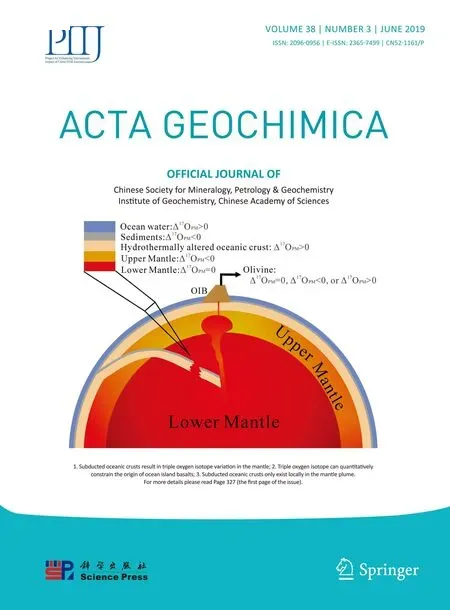Using trace elements of magnetite to constrain the origin of the Pingchuan hydrothermal low-Ti magnetite deposit in the Panxi area,SW China
Yanjun Wang·Weiguang Zhu·Hong Zhong·Zhongjie Bai·Junhua Yao·Chong Xu
Abstract The Pingchuan iron deposit,located in the Yanyuan region of Sichuan Province,SW China,has an ore reserve of 40 Mt with~60 wt%Fe.Its genesis is still poorly understood.The Pingchuan iron deposit has a paragenetic sequenceof an early Fe-oxide–Pyritestage(I)and a late Fe-oxide–pyrrhotite stage(II).Stage I magnetite grainsaregenerally fragmented,euhedral–subhedral,largesized crystals accompanying with slightly postdated pyrite.Stage II magnetite grains are mostly unfragmented,anhedral,relatively small-sized grains that co-exist with pyrrhotite.Combined with micro-textural features and previously-obtained geochronological data,we consider that these two stages of iron mineralization in the Pingchuan deposit correspond to the Permian ELIPmagmatism and Cenozoic fault activity event.Both the Stage I and II magnetites are characterized with overall lower contents of trace elements(including Cr,Ti,V,and Ni)than the ELIP magmatic magnetite,which suggests a hydrothermal origin for them.‘‘Skarn-like’’enrichment in Sn,Mn,and Zn in the Stage I magnetite grains indicate signif icant material contributions from carbonate wall-rocks due to water–rock interaction in ore-forming processes.Stage II magnetite grains contain higher Mn concentrations than Stage I magnetitegrains,which possibly impliesmorecontribution from carbonate rocks.In multiple-element diagrams,the Stage I magnetite shows systematic similarities to Kirunatype magnetite rather than those from other types of deposits.Combined with geological features and previous studieson oxygen isotopes,we conclude that hydrothermal f luids have played a key role in the generation of the Pingchuan low-Ti iron deposit.
Keywords SW China·Pingchuan iron deposit·Low-Ti iron deposit·Hydrothermal magnetite
1 Introduction
The~260 Ma Emeishan Large Igneous Province formed a massive volcanic succession of predominately basaltic f lows and pyroclastics,and minor picrite and trachyte/rhyolite,with associated numerous ultramaf ic–maf ic to felsic plutons in southwestern China(Chung and Jahn 1995;Zhang et al.2006;Shellnutt et al.2012).Along with the mantle plume event,several world-class magmatic Fe–Ti–V deposits,including the Taihe,Baima,Hongge,and Panzhihua deposits,occurred in thewestern Yangtze Block(Song et al.2005,2009,2013;Zhou et al.2005;Bai et al.2012a,b;Chen et al.2014).Thesedepositshaveattracted a lot of interest of many researchers due to their large quantity of Fe–Ti–V oxide ores with a grade at~33 wt%Fe(Ma et al.2003).Other than magmatic,high-Ti iron deposits,there are also low-Ti iron deposits,represented by the Pingchuan,Niuchang and Lanzhichang deposits,within the ELIP.The low-Ti iron deposits are characterized with relatively higher iron ore grade(>40 wt%Fe)and smaller reserves(<50 Mt iron ores).Their origin is still poorly understood because little attention has been paid to them.In thisstudy,wepresent amicrophotographic study and insitu LA–ICP–MStraceelementsof magnetitegrainsfor the Pingchuan deposit.This dataset would allow us to explore the origin of magnetite from the Pingchuan deposit and further compare them with magnetite from other types of deposits,thus shedding light on the genesis of the low-Ti iron deposit.
2 Geological background and sampling
The Yangtze Block is separated from the North China Block to the north,the Cathaysia Block to the south,the Songpan–Ganzi fold belt to the northwest and the Simao Block to the southwest.The study area is located in the western Yangtze Block.The western part of the block consistsof a Paleo–Mesoproterozoic basement,represented by the Dahongshan,Hekou,Kunyang,and Huili Groups.These groups are mainly comprised of low-grade metasedimentary rock with felsic and maf ic metavolcanic interlayers.Numerous mid-Neoproterozoic igneous rocks,dominated by felsic intrusive and extrusive rocks with subordinate ultramaf ic–maf ic lavas and dikes,also crop out in the region(Li et al.2003,2006;Zhou et al.2006).The basement is overlain by Sinian(850–610 Ma)to Permian strata of clastic,carbonate and meta-volcanic rocks with a total sequence more than 9 km(SBGMR 1991).
The Pingchuan region in Sichuan Province has a wellpreserved sedimentary sequence from Early Carboniferous to Early Permian.The Carboniferous strata include the early argillaceous limestones of Weining Formation and the late sandstones and limestones of Mapping Formation.The Early Permian rocks are characterized by the Shuhe,Yangxin(Maokou)and Pingchuan Formations,mainly consisting of limestones with minor siltstone and shale,from bottom up.Late Permian Emeishan volcanic succession overlies these rocks.As shown in Figs.1 and 2,abundant ELIP-associated~260 Ma maf ic and ultramaf ic intrusions also intrude into these strata. The 260.0–260.3 Ma Dabanshan gabbro(Wang et al.2012;Zeng et al.2013;Liu et al.2015b)crop out in the northeast of the Pingchuan iron deposit(Fig.2a).Plenty of picritic dykes show intimate spatial association with the Pingchuan deposit(Figs.2b,3a).These picritic porphyry dykes were thought to beemplaced at~248 Ma(Zeng et al.2013)on thebiasof limited analytic data.Liu et al.(2015b)reported apatite U–Pb age of 245±26 Ma for the Pingchuan iron deposit.
The Pingchuan iron deposit has an estimated reserve of 40 Mt iron ores at~60 wt%Fe.Orebodies are generally in stratiform,lentoid,irregular and vein shapes.Iron ores,despite massive,brecciated,disseminated and stockwork types,mainly contain magnetite with minor siderite and pyrite and variable gangue minerals like dolomite,calcite,apatite,and chlorite.Samples in this study are generally massive ores with high grade and were collected from the most important orebody I,which mainly develops in the contact zone between the picritic dykes and Yangxin(Maokou)limestones.Other orebodies such as orebody II,IIIand IV wereeither small in scaleor hasbeen mined out.Brecciated limestone and carbonate minerals-rich veins could be observed(Fig.3b–d).
Under a microscope,magnetite grains are divided into two stages(Fig.4).Stage Imagnetite grains are euhedral–subhedral crystals with large size mostly>200μm in diameter(Fig.4a,b).Some grains even exhibit oscillatory zones,where tiny inclusions linearly occur along with lattice plane(Fig.4b).Stage I magnetite grains are generally fragmented and surrounded by postdated sulf ides(Fig.4a–d),which are mostly anhedral pyrite grains.Locally,martitization occur along the fractures in massive magnetite(Fig.4c).Whereas Stage IImagnetite grains are characterized with relatively small-sized anhedral grains(mostly<200μm).They usually contain abundant tiny gangue mineral inclusions,which distribute randomly within magnetite grains(Fig.4e–f).Interestingly,Stage II magnetites have experienced little fragmentation and martitization.Sulf ides(mostly pyrrhotite grains)occur along with or within these magnetite grains(Fig.4e–f).
Microscopic observations suggest that the large-sized Stage I magnetite grains formed prior to pyrite and hematite,whereas the anhedral Stage II magnetite grains are almost synchronous with pyrrhotite.Stage I magnetite grains were signif icantly overprinted by fragmentation events,which have not affected Stage II magnetite grains,suggesting that Stage Imagnetiteformed earlier than Stage II magnetite.Therefore,the Pingchuan deposit has a paragenetic sequence of an early Fe-oxide(Stage Imagnetite)and subsequent sulf ide stage(pyrite),and a following late Fe-oxide(Stage II magnetite)and almost simultaneous sulf ide stage(pyrrhotite).
3 Analytical method
Major element compositions of ore samples for the Pingchuan deposit were determined using X-ray f luorescence spectrometers(XRF)at ALSChemex Co Ltd,Guangzhou.The analytical precision is generally better than 5%.
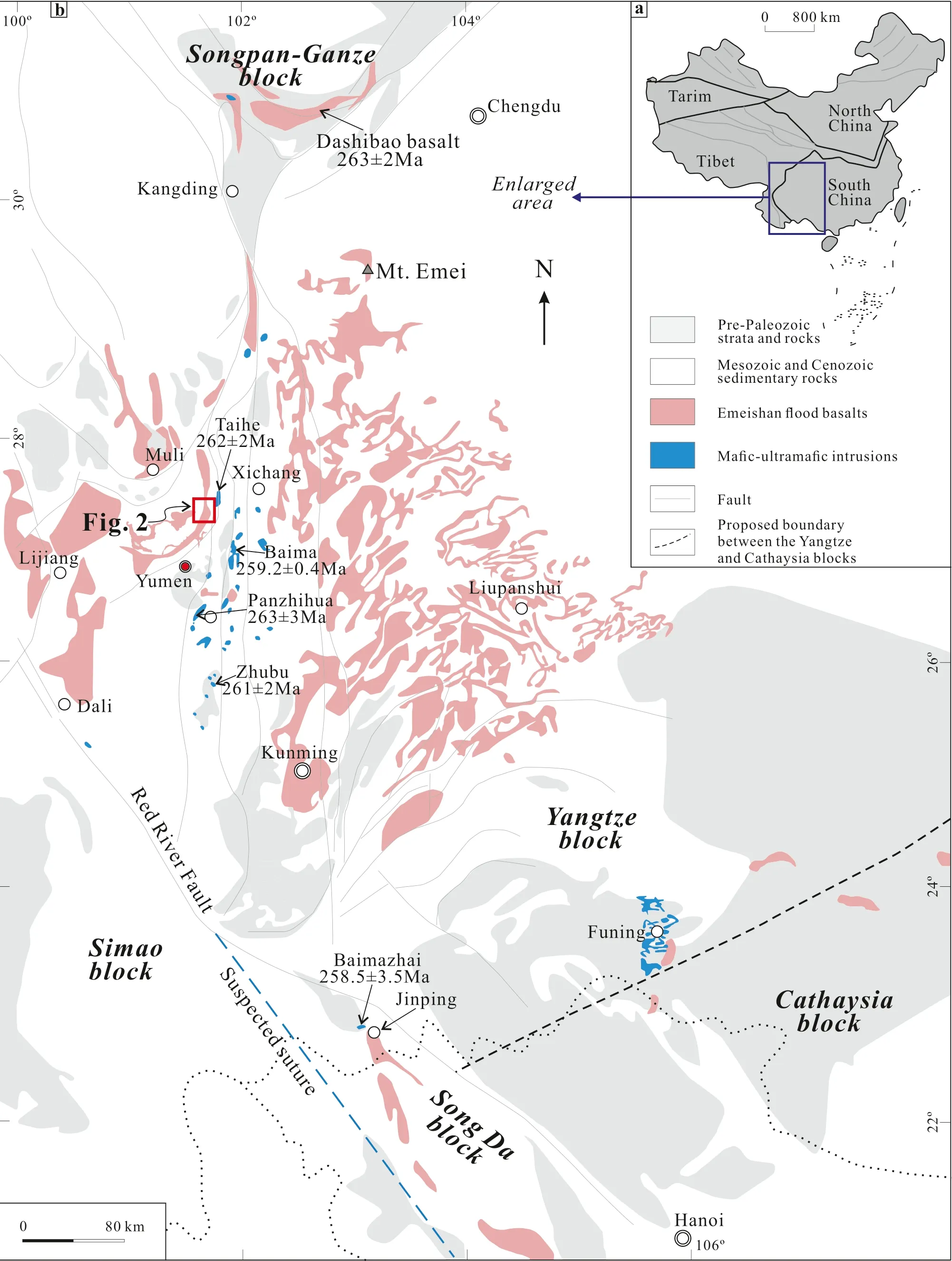
Fig.1 a Schematic map showing the tectonic framework of China.▶b Schematic geologic map showing the distribution of the magmatic Fe–Ti–V oxide ores of the Emeishan Large Igneous Province in SW China(modif ied after Song et al.2009).Red square is shown Fig.2a
Magnetite grains in seven thin slices were chosen for LA–ICP–MS trace element determination.Analyses were conducted using a Coherent GeoLasPro 193-nm Laser Ablation system coupled with an Agilent 7700×ICP-MS at the SKLODG,IGCAS.Operating conditions and procedures are similar to those described in Gao et al.(2013).During the ablation,a repetition rate of 5 Hz and a laser spot size of 44μm were adopted.Helium worked as the carrier gasand subsequently wasmixed with argon gasin a T-connector prior to mass spectrometric analysis.Each analysis comprises 20s background on a gas blank and 60s analysis on unknown or standard materials.Several reference materialsincluding BC-28,BCR-2G,GOR-128,GSE-1G and NIST 610 were analyzed to calibrate trace element contents with57Fe as the internal standard.Every eight unknown analyseswere separated by GSE-1G with another standard to monitor time-dependent drift of sensitivity and mass discrimination.Off line data reduction was performed using ICPMSDataCal program(Liu et al.2008)with Fe2+/ΣFe values of 0.33(Liu et al.2015b).
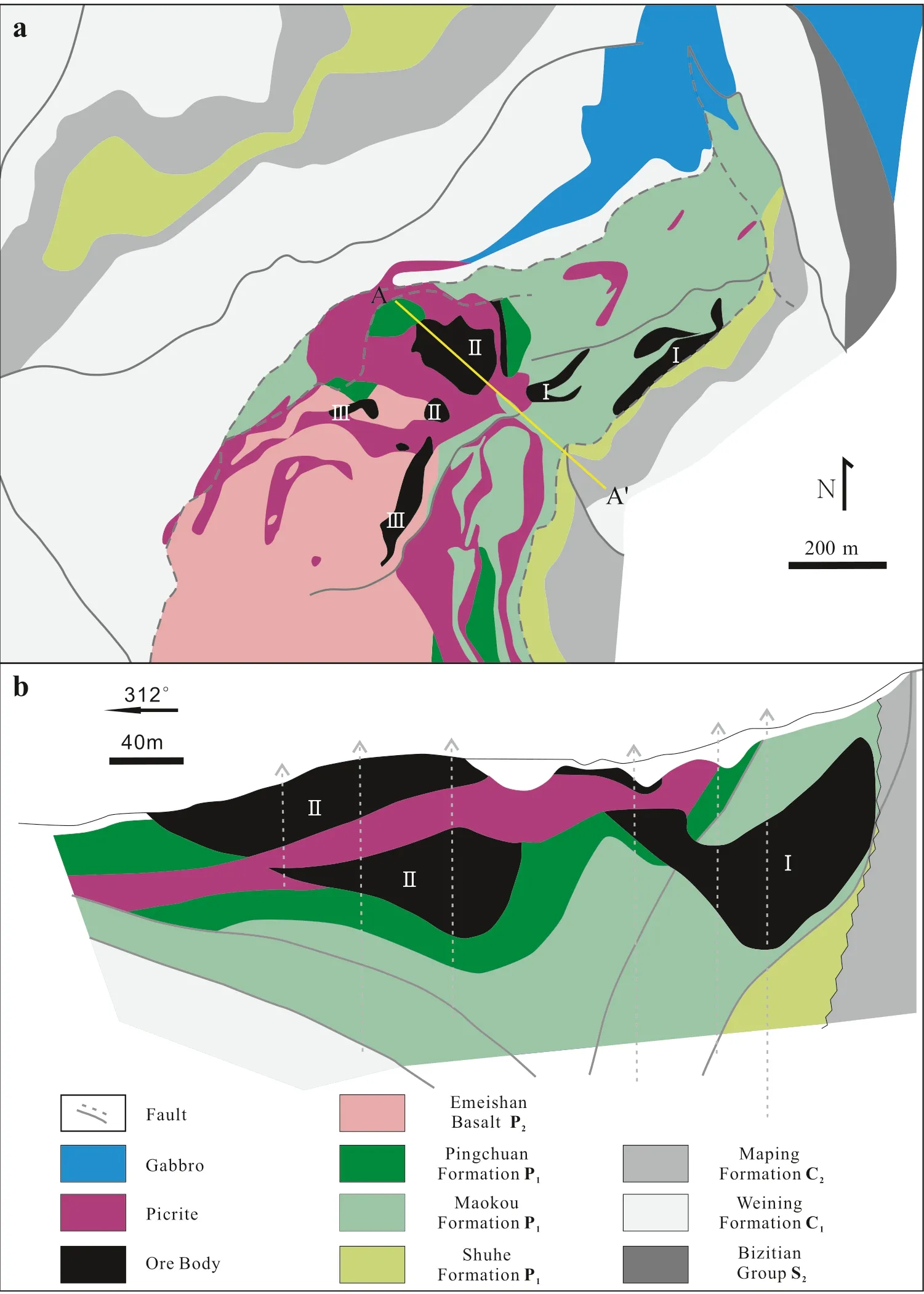
Fig.2 a Geologic map of the Pingchuan iron deposit and b cross section of A–A′exploration line(modif ied after Panxi Geological Team 1982)
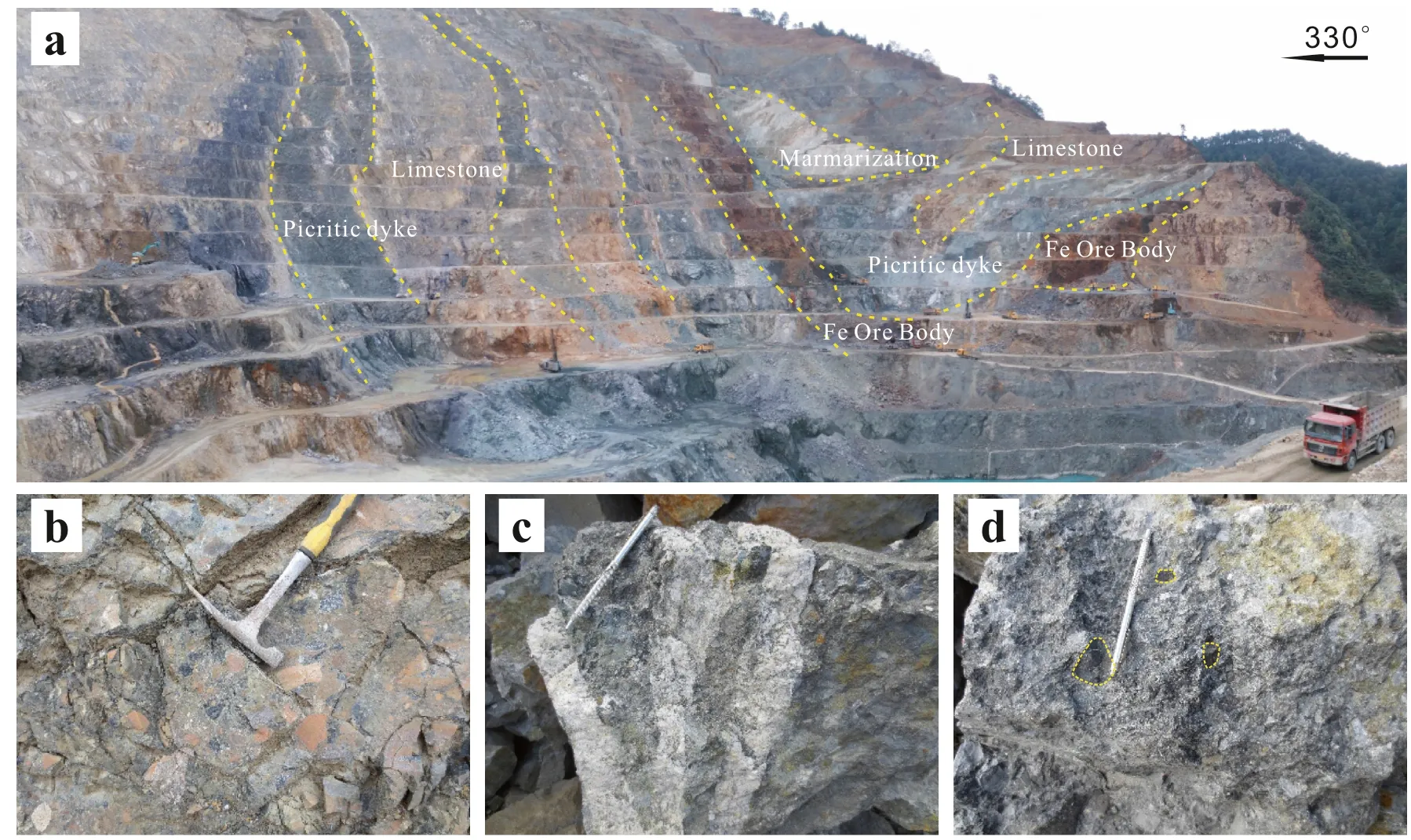
Fig.3 a An overview of the Pingchuan open pit,showing f ield relationships of Fe orebodies,limestones and picritic dykes.b–d Representative brecciate rocks and carbonate veins in the mining district
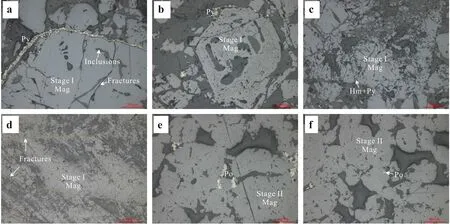
Fig.4 Microphotographic pictures of a large-sized,b oscillatory zones,c–d fragmented Stage I magnetite and e–f unfragmented,Po-bearing Stage II magnetite.Abbreviations:Hm hematite,Mag magnetite,Po pyrrhotite,Py Pyrite
4 Results
Major elements of ore samples from the Pingchuan deposit are listed in Table 1.Ore samples are generally characterized with high contents of Fe2O3(55.6–87.1 wt%;Fe=38.9–61.0 wt%)and moderate MgO(2.68–7.82 wt%)and CaO(4.74–15.3 wt%)contents.Other oxides,such as TiO2and P2O5,are very low in the Pingchuan deposit.LOI values are high in these samples,agreeable with the presence of gangue carbonate minerals.
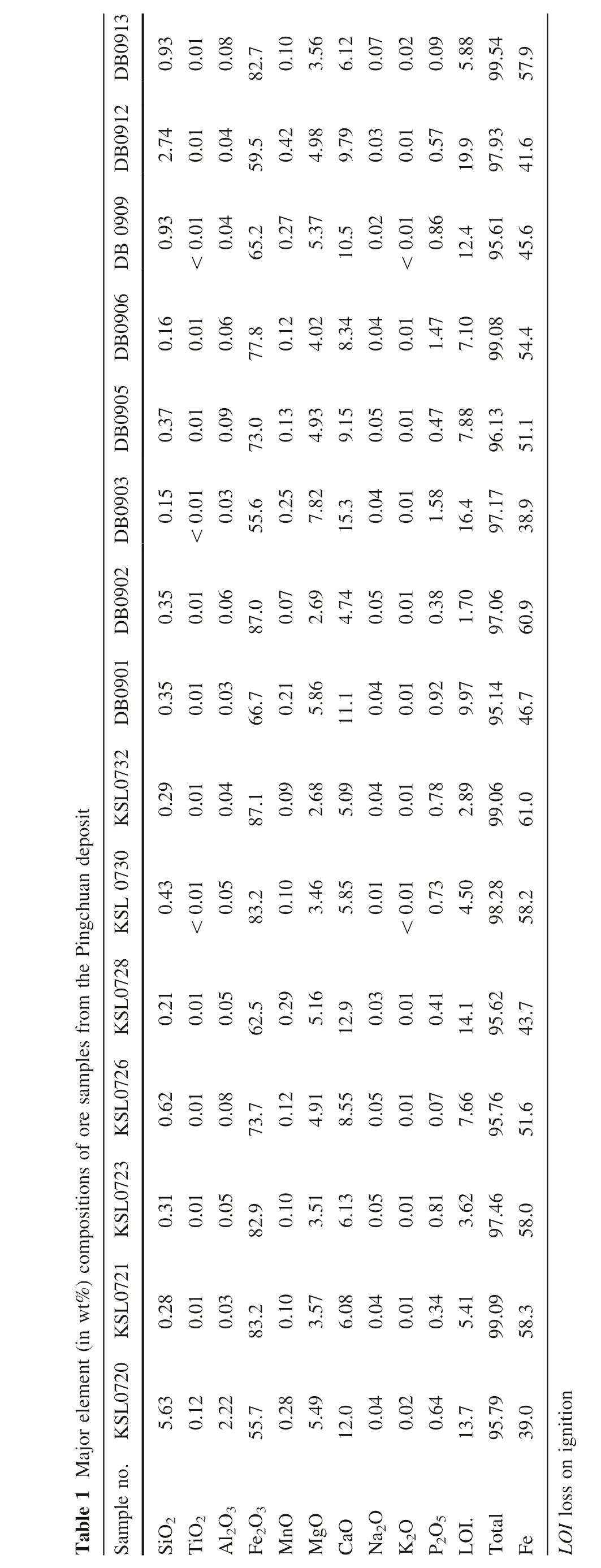
DB0913 DB0912 0909 DB DB0906 DB0905 DB0903 DB0902 DB0901 0.93 0.01 0.08 82.7 0.10 3.56 6.12 0.07 0.02 0.09 5.88 99.54 57.9 2.74 0.01 0.04 59.5 0.42 4.98 9.79 0.03 0.01 0.57 19.9 97.93 41.6 0.93<0.01 0.04 65.2 0.27 5.37 10.5 0.02<0.01 0.86 12.4 95.61 45.6 0.16 0.01 0.06 77.8 0.12 4.02 8.34 0.04 0.01 1.47 7.10 99.08 54.4 0.37 0.01 0.09 73.0 0.13 4.93 9.15 0.05 0.01 0.47 7.88 96.13 51.1 0.15<0.01 0.03 55.6 0.25 7.82 15.3 0.04 0.01 1.58 16.4 97.17 38.9 0.35 0.01 0.06 87.0 0.07 2.69 4.74 0.05 0.01 0.38 1.70 97.06 60.9 0.35 0.01 0.03 66.7 0.21 5.86 11.1 0.04 0.01 0.92 9.97 95.14 46.7 Table1Majorelement(inwt%)compositionsoforesamplesfromthePingchuandeposit KSL0732 KSL0730 KSL0728 KSL0726 KSL0723 KSL0721 KSL0720 Sampleno.0.29 0.01 0.04 87.1 0.09 2.68 5.09 0.04 0.01 0.78 2.89 99.06 61.0 0.43<0.01 0.05 83.2 0.10 3.46 5.85 0.01<0.01 0.73 4.50 98.28 58.2 0.21 0.01 0.05 62.5 0.29 5.16 12.9 0.03 0.01 0.41 14.1 95.62 43.7 0.62 0.01 0.08 73.7 0.12 4.91 8.55 0.05 0.01 0.07 7.66 95.76 51.6 0.31 0.01 0.05 82.9 0.10 3.51 6.13 0.05 0.01 0.81 3.62 97.46 58.0 0.28 0.01 0.03 83.2 0.10 3.57 6.08 0.04 0.01 0.34 5.41 99.09 58.3 5.63 0.12 2.22 55.7 0.28 5.49 12.0 0.04 0.02 0.64 13.7 95.79 39.0 SiO2 TiO2 Al 2O3 Fe2O3 MnO MgO CaO Na2O K2O P2O5 LOI.Total Fe LOI lossonignition
Trace elements of magnetite grains determined by LA–ICP–MS are presented in‘Appendix’.Stage I magnetite grains have substantial Si(678–7561 ppm),Mg(4.66–7158 ppm),Mn(9.19–322 ppm),Ca(4.55–3136 ppm),V(118–522 ppm),Zn(13.8–134 ppm),Al(12.0–129 ppm),Sn(10.7–38.2 ppm)and Co(0.30–38.5 ppm),which are much abovedetection limits.Ti(<67.5 ppm),Cr(<5.83 ppm),Ni(<2.85 ppm),Ga(<1.05 ppm),Sc(<0.31 ppm)and other elements in these grains are either close to,or below detection limits.Stage IImagnetite grains contain variable ranges of Si(624–3378 ppm),Mg(68.9–6998 ppm),Ca(2.50–1874 ppm),V(94.6–363 ppm),Zn(17.2–440 ppm),Al(19.3–257 ppm),Sn(8.32–69.7 ppm),Co(1.83–47.7 ppm),Ti(<19.9 ppm),Cr(<1.66 ppm),Ni(<6.21 ppm),and Sc(<0.12 ppm)similar to those of Stage I magnetite grains.However,most Stage IImagnetitegrainshaveslightly higher Mn(16.3–871 ppm)and lower Ga(<0.59 ppm)thanthoseof Stage Imagnetitegrains.
5 Discussion
5.1 Origin of magnetite
In the Pingchuan deposit,apatite grains accompanied with Stage Imagnetiteyieldsa U–Pb ageof 245±26 Maand a f ission-track age of 51.8±4.9 Ma(Liu et al.2015b),representing mineralization age and late thermal event,respectively.The former is overlapped with the~260 Ma ELIPbasalts and gabbros(e.g.,Aliet al.2005;Zhong et al.2011;Wang et al.2012;Zeng et al.2013;Liu et al.2015b)within error.Whereas,the latter event has experienced slow cooling at 70–24 Ma and fast cooling after 24 Ma(Liu et al.2015b),coeval with~67 Ma metamorphism record in picritic dikes(Zeng et al.2013).This event is possibly linked to the thrust of the Cenozoic Jinqing fault(Ge 1984;Zhong et al.2004)as suggested by Liu et al.(2015b).Combined with the contrasting fragmentation and inclusion-distribution features,we consider that the early Fe oxide(–sulf ide)Stage is closely associated with the ELIPmagmatic event and the late Feoxide(–sulf ide)Stage is intimately connected with Cenozoic fault activity.This interpretation is further supported by a decrease of sulf idation state from pyrite to pyrrhotite(Einaudi et al.2003),which is identical to a drop of temperature and/or sulfur fugacity in the ore-forming system from magmatic-related to fault-related environments.
In Figs.5 and 6,the Stage I and Stage II magnetite grains of the Pingchuan magnetite share very similar chemical compositions except for higher Mn contents in Stage II magnetites.Because high Mn is a signif icant feature for carbonate rocks,fault activities in carbonate rocks would lead to f luids enriched in Mn.Combined with geochronological data and micro-textural features,we suggest that the Stage IImagnetites are recrystallized from Stage I magnetite grains under the inf luence of fault-induced Mn-rich f luids.While the chemistry of the Stage I magnetites are genetically related to the Emeishan magmatism and would provide convincingly constraints on the origin of the Pingchuan deposit.

Fig.5 a Chemical discrimination diagram for magnetite from magmatic and hydrothermal environments after Nadoll et al.(2014).b Chemical discrimination diagram for magnetite from different typedepositsafter Dupuisand Beaudoin(2011)modif ied by Nadoll et al.(2014).Data of Emeishan magmatic magnetite come from Liu et al.(2015a)
5.2 Genesis of the Pingchuan iron deposit
Elements such as Cr,Ti,V,and Ni usually show high contents in a magmatic system but low contents in a hydrothermal system,so they could be applied to discriminate magnetite formed in these systems(Dare et al.2014;Knipping et al.2015a;Nadoll et al.2015;Wang et al.2018).Asshown in Figs.5 and 6,both the Stage Iand Stage II magnetite grains of the Pingchuan magnetite are with low concentrations of Ti,V,Ni,Cr,and Al+Mn,which are much lower than those in the regional coeval Emeishan magmatic magnetite grains.Actually,they are plotted into the f ield close to hydrothermal magnetite area designed by Nadoll et al.(2015).
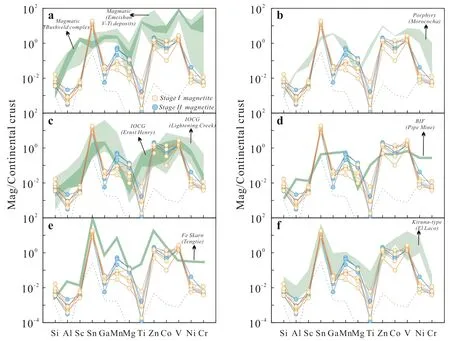
Fig.6 Continental-crust normalized multiple elements diagrams for the Pingchuan magnetite grains(Stage I and Stage II).Also shown magnetite compositions of magmatic(a),porphyry(b),IOCG(c),BIF(d),skarn(e)and Kiruna-type(f)deposits.The diagrams are designed after Dare et al.(2014).Data are cited from Rudnick and Gao(2003),Carew(2004),Dare et al.(2014),Liu et al.(2015a)and Zhao and Zhou(2015)
Multiple trace elements in magnetite grains were also suggested to be able to identify ore-forming environments and ore deposit types(Dupuis and Beaudoin 2011;Dare et al.2014;Nadoll et al.2014;Broughm et al.2017).In Fig.6,the Stage I magnetites of the Pingchuan deposit exhibit spiked multiple-element patterns with depletions in Al,Ga,Ti,Ni,and Cr,and enrichmentsin Sn,Mn,and Zn–Co–V.These patterns are distinct from those of the magmatic magnetite,which have relatively smooth right-inclined patternswith overall high contentsof trace elements(Fig.6a).This comparison precludes purely magmaticsystem environments,such as extremely high-temperature,for the Stage I magnetites.Moreover,they are also different from the M-shaped patternswith peaksin Sn–Gaand Ni–V–Co(–Zn)and troughsin Si,Mg and Cr for magnetite from magmatic–hydrothermal porphyry and IOCG(ironoxide copper and gold)deposits(Fig.6b,c).The Stage I magnetite grains contain much lower Ni,Ga,Ti,and Al than porphyry and IOCGmagnetite.Theseobservationsare arguing that magmatic–hydrothermal environments alone could not account for the compositions of the Stage I magnetites.In addition,the Stage I magnetites can be distinguished from BIF magnetite,which shows a relative f lat pattern and high Ni–Cr–Ga(Fig.6d).Interestingly,the Stage I magnetite grains also display enrichments in Sn,Mn,and Zn–Co relativeto neighboring elementssimilar to,although in low level,those of skarn deposits(Fig.6e).This indicates signif icant skarn-like wall rock contribution during thegeneration of the Stage Imineralization.In more details,they show collectively similarities to Kiruna-type magnetite in El Laco except for pronounced lower Ni concentrations(Fig.6f).Generally,Stage I magnetites have exhibited more aff inities with magnetite from Kirunatype and skarn deposit than other types of deposits.
Previous studies have proposed both magmatic and hydrothermal models for the generation of low-Ti iron deposit within ELIP(Yang 1983;Yao and Yan 1991;Wang et al.2014;Liu et al.2015b).Yao and Yan(1991)reported amygdaloidal structures in massive ores of the Niuchang deposit,which located to the south of the Pingchuan deposit.Recently,Liu et al.(2015b)interpreted that these deposits resulted from low-Ti Fe-rich melts separated from low-Ti basaltic magmas based on a Fe2O3*drop of 4.51%from gabbro to gabbronorite.However,alteration style,and ore and mineral geochemistry tend to support a hydrothermal origin for the Pingchuan deposit(Yang 1983;Wang et al.2014).As aforementioned,the Pingchuan deposit exhibits comparable magnetite multiple-element pattern with the Kiruna-type iron deposits in El Laco,which also bear low-Ti features.There are also similar long-living debates over the genesis of Kiruna-type deposits(mainly iron-rich hydrothermal f luids and magmatic iron-rich melts)(see more details in Knipping et al.(2015b).However,a novel model established recently by Knipping et al.(2015a,b)seems to be able to coordinate the contrasting co-occurrence of purely magmatic and hydrothermal observations.They proposed that magmatic magnetite-bubble suspension separated from magmatic magmas deposit massive magnetite in regional faults.This model actually signif ies the role of hydrothermal f luids,consistent with the overall trace-element features of magnetite for Kiruna-type deposits.
In the Pingchuan deposit,Stage I magnetites have hydrothermal origins,arguing against purely magmatic iron-rich melts model.The following lines of evidence also support them to a hydrothermal model for the Pingchuan deposit.(1)Orebodies preferentially occur in the contact zone between limestones and picritic dykes.This is in contrast with the purely magmatic iron-rich melts model,which should expect more spatially association with the regional gabbros(Fig.2).(2)Oresamplesin the Pingchuan deposit contain low P2O5contents(<1.58%;Table 1)which are crucial for the separation of an iron-rich oxide meltsfrom a Si-rich silicate melt(Hou et al.2018),arguing against a parental Fe–P-rich melts for the Pingchuan deposit.(3)Gangue minerals are dominated by carbonate minerals(Table 1),identical to the lithology of host rocks.(4)Along with orebodies,extensive alterations(e.g.,marmarization)of host rocks have been observed(Fig.3a).More skarn minerals,such as diopside,actinolite,and epidote,have been documented in the ore district(Wang et al.2014).(5)Abundant gangue mineral inclusions,e.g.,carbonate minerals,occur in Stage I magnetites(Fig.4),which is common in the hydrothermal system.(6)Some Stage I magnetite grains in the Pingchuan deposit exhibit oscillatory zones,similar to the typical structure for skarntype high-temperature magnetite(Zhao and Zhou 2015).(7)Theδ18O values of magnetite(although we do not know which stage they belong to)in this deposit are consistent with magmatic-water origin rather than pure mantlederived magma origin(Wang et al.2014).Therefore,hydrothermal f luids are crucial for the generation of the Pingchuan deposit.
The enrichment in Sn–Mn–Zn are typical features of skarn magnetite(Fig.6e).Along with the emplacement of picritic dykes,primary ore-forming f luids reacted with limestones,depositing the Sn–Mn–Zn-rich Stage I magnetite grains with accessory apatite.During the Cenozoic fault activities,previously formed minerals suffered from fragmentation and inclusion-rich Stage II magnetite grains were generated.These f luids contain abundant carbonate components and lead to more elevated Mn–Al in Stage II magnetite grains relative to previousmagnetite grains.This possibly indicates that the f luids have more contributions from carbonate wall rocks,might consistent with the presence of hydrothermal carbonate veins in breccia rocks in the ore district.Although the magmatic magnetite-bubble suspension model(Knipping et al.2015a,b)could not be precluded,we still infer that the Pingchuan deposit is hydrothermal in origin on the bias of available data.The early ore-forming f luids were possibly magmatic–hydrothermal in origin,whereas the late f luids might be induced from fault activity.However,it still requires more studies on the nature of ore-forming f luids to explain chemical divergences,such Al–Ti–Ni–Cr,between the Pingchuan and typical skarn magnetite.
6Conclusion
Two stages of magnetite grains were identif ied in the Pingchuan iron deposit:early fragmented,euhedral–subhedral,large-sized magnetite grains and late unfragmented anhedral,small-sized magnetite grains.They correspond to Permian magmatism and Cenozoic thermal event.Both the early and late magnetite grains show signatures of hydrothermal magnetite,which supports a hydrothermal origin for the deposit.Contributions from carbonate wall rocks are signif icant in the ore-forming processes.
AcknowledgementsThis study was supported by the National Natural Science Foundation of China(Grants 41572074 and 41273049)and the Strategic Priority Research Program of the Chinese Academy of Sciences(Grant No.XDB18030204).We thank Dr.Zhihui Daifor her assistance in magnetite analyses using LA-ICP-MS.Local engineers from the Pingchuan deposit are also appreciated for their help in f ield work.
Appendix

LA-ICP-MStrace elemental compositions of magnetite from the Pingchuan deposit in the ELIP
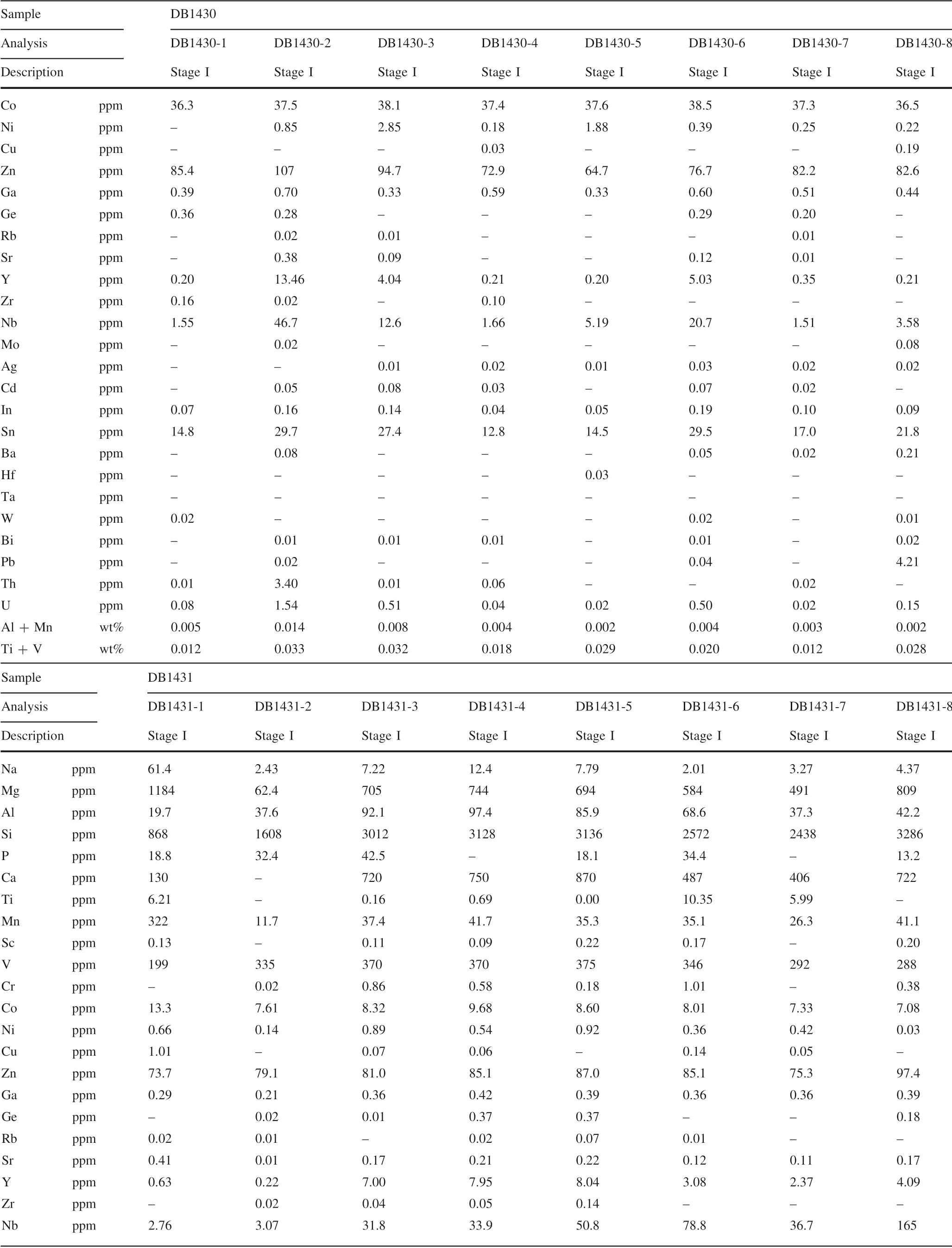
continued

continued
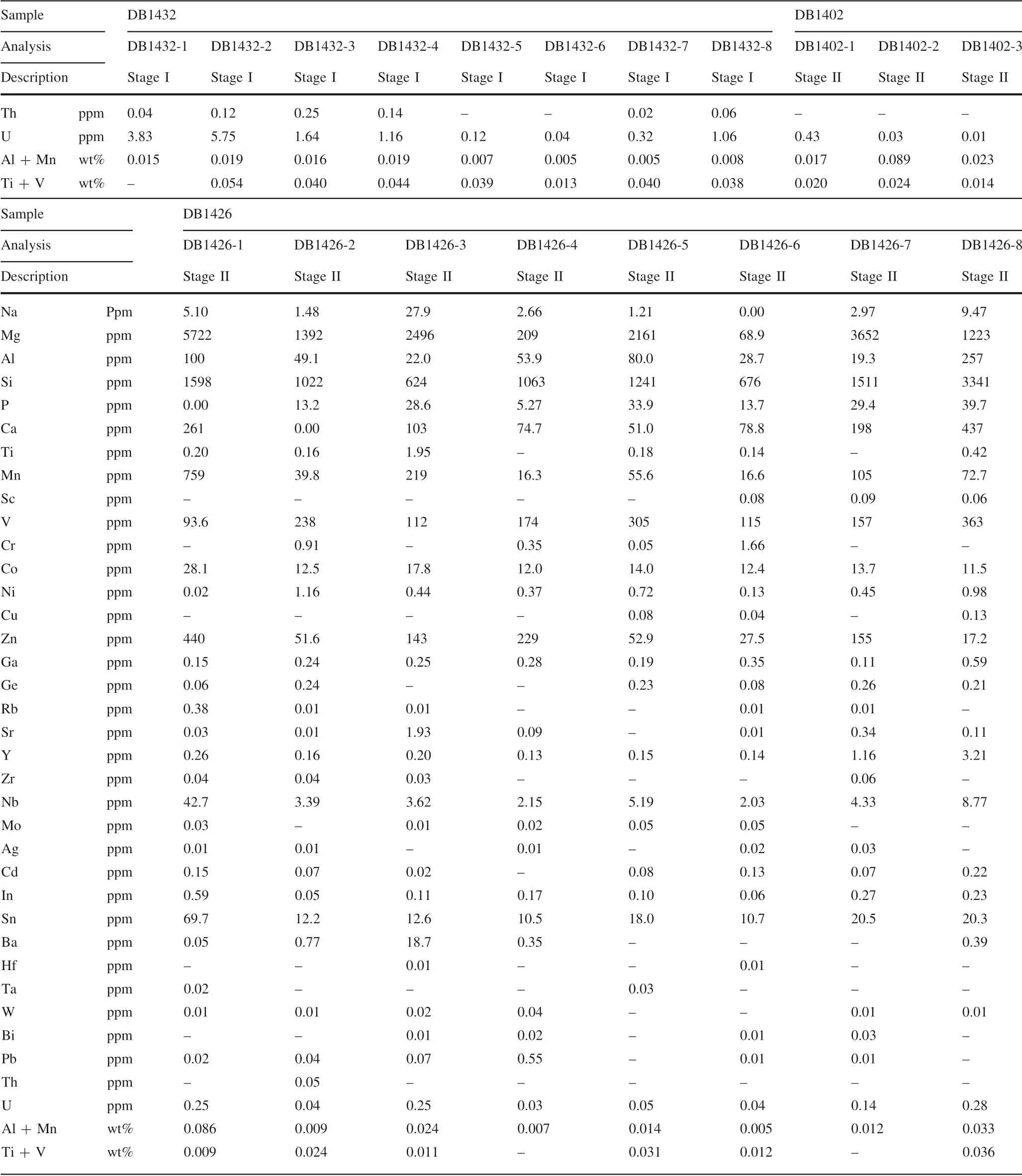
continued

continued
- Acta Geochimica的其它文章
- Correction to:The enhanced element enrichment in the supercritical states of granite-pegmatite systems
- Hydrogeochemical evaluation and statistical analysis of groundwater of Sylhet,north-eastern Bangladesh
- Effects of mineral-organic fertilizer on the biomass of green Chinese cabbage and potential carbon sequestration ability in karst areas of Southwest China
- Trace element partitioning between amphibole and hydrous silicate glasses at 0.6-2.6 GPa
- Geochemistry of subsurface Late Quaternary ironstones in Rajshahi and Bogra Districts,Bangladesh:implications for genetic and depositional conditions
- Mercury speciation,bioavailability and risk assessment on soil-rice systems from a watershed impacted by abandoned Hg mine-waste tailings

